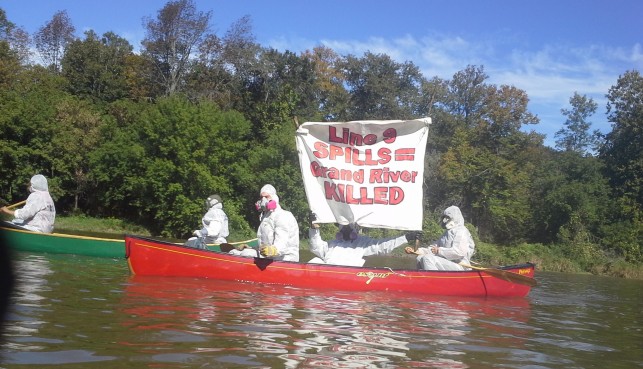Opponents of Enbridge’s Line 9B pipeline in Southern Ontario are scrambling in the wake of its tentative approval earlier this month by the National Energy Board to highlight just how dangerous overhauling the 38-year-old, 639-kilometre pipeline could be for flora and fauna alike.
Opponents of Enbridge’s Line 9B pipeline in Southern Ontario are scrambling in the wake of its tentative approval earlier this month by the National Energy Board to highlight just how dangerous overhauling the 38-year-old, 639-kilometre pipeline could be for flora and fauna alike.
Approximately 100 protesters, First Nations members, students and concerned citizens gathered on the front lawn of Queen’s Park in Toronto the day after the NEB’s ruling was made, calling on Ontario Premier Kathleen Wynne to take a more active role in opposing the pipeline.
The Liberal government has a good track record of implementing environmental legislation, they argued, including the phase out of coal in electricity generation, creating the Greenbelt, and implementing clean water and waste reduction legislation. But now they need to “stand up for Ontarians” and, at a minimum, conduct a provincial environmental assessment to better know the dangers.
The Premier and her Minister of Energy, Bob Chiarelli, have so far shown no interest in conducting an assessment on the Line 9B project. Chiarelli did, however, order the province’s energy regulator to conduct public consultations on the Energy East Pipeline project from TransCanada set to carry crude in Ontario from Kenora to the Ottawa Valley and into Quebec and New Brunswick.
Rising Tide Toronto also released a report by experts and community members earlier this month. The report, Not Worth the Risk, calls into question the sense of retrofitting the aging pipeline to carry crude oil from Western Canada and the Bakken region of the United States to Quebec refineries if it must pass through the neighbourhoods of 9 million Ontarians, 18 First Nations, sensitive ecosystems and dozens of watersheds supplying drinking water for millions.
The Niagara Escarpment, the Rouge River, the Algonquin to Adirondack Corridor and vast stretches of Ontario’s prime farmland would all be put at risk by potential leaks or ruptures, the report states. What’s worse, during public hearings opponents called for hydrostatic testing – a process to send pressurized water through the pipeline to easily identify potential weak points – to be conducted. The reasonable request was rejected not only by Enbridge, but also, more surprisingly, by the NEB.
Enbridge’s failure to carry $1-billion in insurance is also a substantial concern. The $685-million the company does carry would be insufficient to address a spill on par with what Enbridge faced in 2010, opponents worry, when 20,000 barrels of crude spilled from a ruptured pipeline into Michigan’s Kalamazoo River. Clean up has taken four years and counting, with costs soaring above the billion dollar mark. It has the dubious honour of being the largest inland oil spill in US history.
RELATED: The Cautionary Tale of Kalamazoo
Options for halting the project are few, but there does remain one glimmer of hope. The energy board refused to grant Enbridge the right to start pumping oil without a final approval on their part and not before the company met a slew of environmental conditions. It may not be much, but opponents have less than a year to stir up public sentiment into political action on Line 9B.
Engineers deconstruct Northern Gateway assessment
Meanwhile, in northern British Columbia, the Concerned Professional Engineers (CPE) released three “risk-focused” white papers last week, hoping to break down the flaws in how Enbridge’s Northern Gateway pipeline to Kitimat was assessed by the NEB’s Joint Review Panel.
Worried about the likelihood and catastrophic results of a marine spill, the reports outline their concerns over the company’s ability to remove dilbit from marine ecosystems and the ongoing fear that taxpayers may be stuck with the bill for cleaning up any spills.
According to the engineering group, Enbridge has made it clear their responsibility for any marine-based spill ends when the oil leaves Kitimat via tankers bound for Asia, and has poorly estimated the risk of a spill in the narrow channel tankers will have to navigate from Kitimat to the open ocean.
“Northern Gateway’s own calculations show that there is a 9% chance of a major spill on the BC coast,” said Brian Gunn, spokesperson for the group. “We went through their math to figure out how they came up with this number, and at the root of it all we found a bunch of unjustified assumptions. This is not how complicated engineering projects are done.”
RELATED: Disasters Foretold: What Enbridge already knows about where and how much Northern Gateway will leak
The Joint Review Panel that investigated the project estimated the total funds available to pay for tanker spills are no more than $1-billion. But as CPE notes, the Exxon Valdez spill was estimated to have cost upwards of $7-billion in damages and cleanup costs.
“The National Energy Board’s Joint Review Panel was irresponsible in its decision to approve the project,” said Gunn. “They ignored testimony and evidence and simply accepted assurances from Northern Gateway that the risks of a major oil spill were small.”
The members of his organization are not against the development of natural resources like the Alberta tar sands, Gunn said, nor are they against shipping that oil via pipeline overland through British Columbia. Many of the group’s members work in various resource industries which makes them well suited to lead this kind of insider analysis.
“But that doesn’t mean these kinds of projects should be rushed through without the proper review,” he said.
Andrew Reeves is the Editor-in-Chief of Alternatives Journal. Overrun, his book about Asian carp in North America, will be published in Spring 2019 by ECW Press. His work has also appeared in the Globe & Mail, Spacing and Corporate Knights. Follow him on Twitter.













